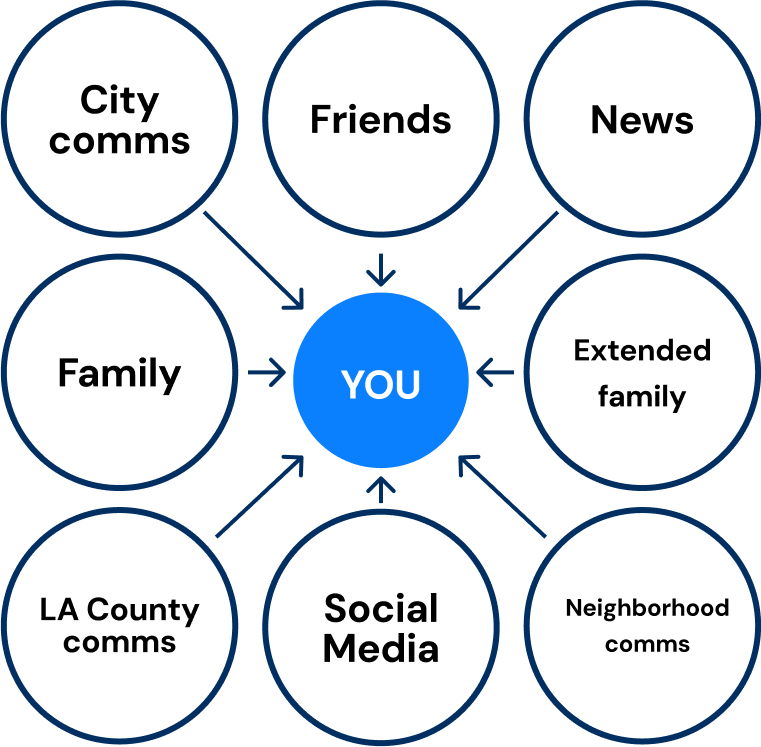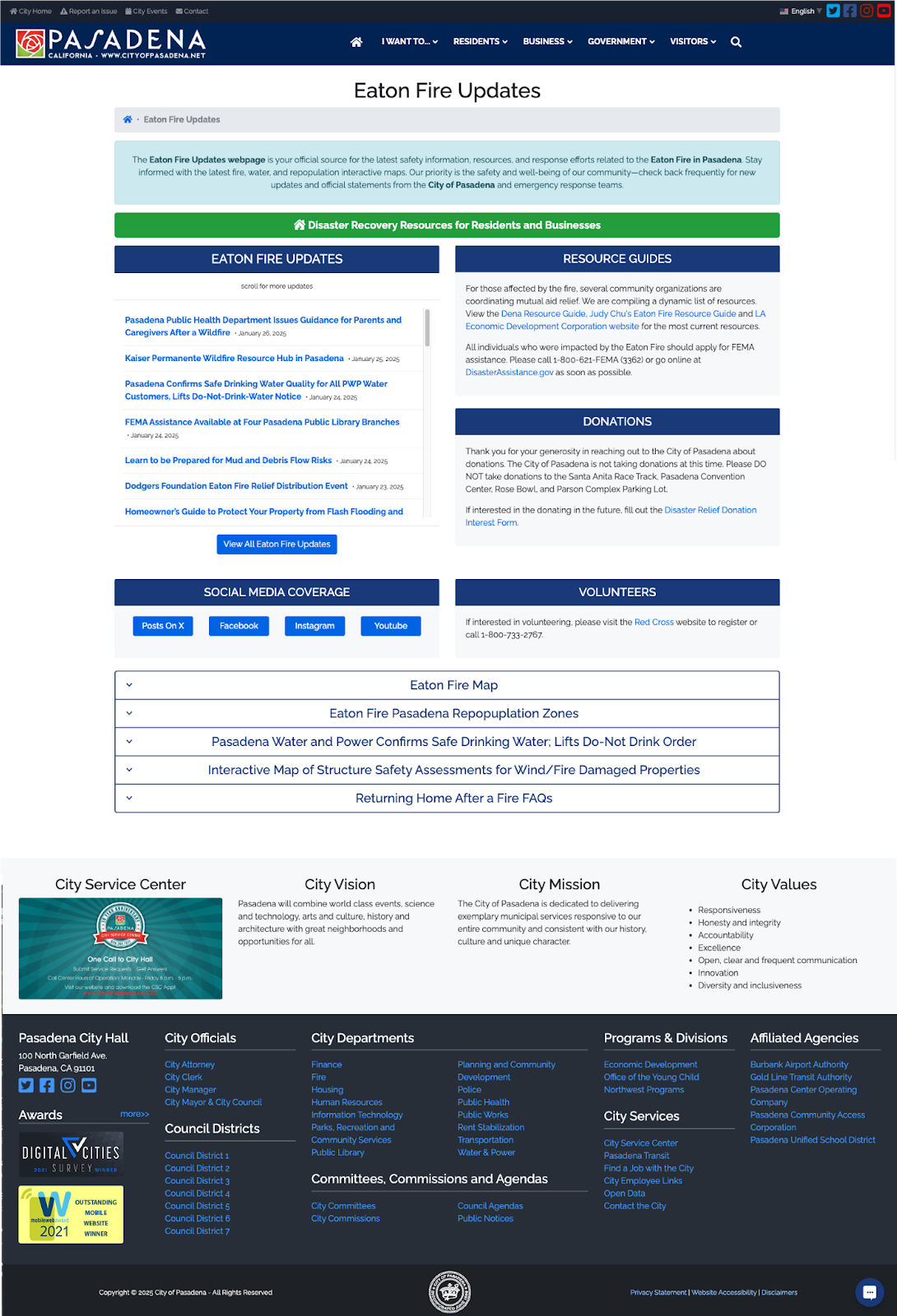When the devastating Eaton Fire erupted in January 2025, the City of Pasadena faced an unprecedented crisis. While neighboring Altadena bore the brunt of property damage, Pasadena suddenly became the regional hub for emergency communications, disaster support, and coordination of services across multiple jurisdictions.
"In the first few days, we were still in the midst of dealing with the fires and evacuation," explained Phillip Leclair, chief information officer (CIO) for the City of Pasadena. "Our IT department was starting to think ahead—what is this going to look like in the next couple of weeks, next month and beyond, for recovery?"
The IT department, typically an internal-facing organization supporting other city departments, found itself thrust into a critical public-facing role. While the City had clear protocols for emergency response and public safety communications, they lacked systems to consolidate information from every department into a unified hub during a city-wide disaster.
"The magnitude of the emergency was huge," Jessica Freeman-Wong, assistant chief information officer at the City of Pasadena said. "All of our resources were being activated just to support the on-the-ground emergency. Normal channels of communication and our normal ways of working together were all sort of tossed up in the air."

While departments across the City had established channels of external communication, stretched-thin resources meant these resources were being combined into "giant bullet lists of information. Pages and pages if you printed them out." Residents and staff affected by the fire reported they couldn't search through piles of information during an emergency. They needed clear next steps, not overwhelming lists.
"After about two weeks, there were so many more needs," Phillip recalled. "The proliferation of information just started getting bigger and bigger. Everyone was starting to issue information—public works, planning, public health, the county, the state. It just became overwhelming."
Why USDR?
Phillip took proactive action early in the crisis, reaching out to CIOs across California who had managed similar disasters. During a call with these leaders and the State CIO, U.S. Digital Response (USDR) was introduced.
While initial discussions covered various technical solutions, the city's needs crystallized as the emergency evolved: they needed to transform their disaster recovery website from a basic information splash page into a truly useful resource for residents.
Our approach
USDR deployed a team of content strategists, user researchers, and emergency communications experts to partner with Pasadena. Despite the city's limited bandwidth during active emergency response, the team adapted their approach to maximize impact while minimizing burden on city staff.
The three-week intensive engagement included:
- Rapid user research with fire-affected residents and City staff to understand information-seeking behaviors during crisis
- Comparative analysis of disaster recovery sites from Los Angeles City and County, as well as other jurisdictions
- Information architecture redesign creating intuitive pathways for residents at different stages of recovery
- Emergency-specific wireframes that account for how people process information under stress
- Process documentation to strengthen the city's capacity for future emergencies
"It was so easy to work with the USDR team. In an emergency situation, that was incredibly helpful. All I needed to do was respond. I had really low bandwidth to shepherd this along, so it was nice knowing that the team's got it," Jessica Freeman-Wong, assistant chief information officer at the City of Pasadena
Technologies and practices used
Technologies:
- Content management systems
- User research tools
- Information architecture mapping
- Wireframing and design tools
Practices:
- Emergency communications best practices
- User experience research
- Content strategy
- Service design
- Cross-jurisdictional coordination
- Plain language writing
The impact
USDR delivered a comprehensive content strategy and redesign that fundamentally changed how Pasadena approaches emergency communications. The public information office (PIO) adopted all recommendations, using the wireframes as the foundation for a site redesign.
"We had really strong communication channels to deliver information quickly, but how do we bring that all into one place? Being able to identify those gaps and put process in place so that the next time something happens, we have a good process—that was invaluable," Jessica said.
Before:

After:

Key outcomes included:
- Process transformation that identified and addressed critical gaps in cross-department information coordination
- Scalable emergency templates enabling rapid deployment for future crises
- User-centered information architecture that reflects how residents actually seek help during emergencies
- Long-term capacity building ensuring the city is better equipped for future emergencies
Before

After

"One of the aha moments was seeing a way to organize the information as a cross-section between where people are in the recovery process and who they are. The wireframe really tried to organize the past, present, and future in terms of what the city is going to do and how to communicate to every audience we could possibly think of, plus multiple languages," Phillip said.
The City of Pasadena's proactive leadership during the Eaton Fire exemplifies how forward-thinking government teams can transform crisis response into lasting infrastructure improvements. While managing an active emergency, Pasadena's IT leadership recognized the opportunity to build better systems for the future. By partnering with USDR, the city gained access to specialized expertise that complemented their team's deep knowledge of community needs. The result: emergency communications infrastructure that will serve Pasadena residents for years to come, ensuring the city is prepared when the next crisis strikes.
The Team
USDR:
- Lisa Carter, user research
- Emilia Navarro, content design
- Rebecca Woodbury, emergency communications expert
City of Pasadena:
- Phillip Leclair, chief information officer
- Jessica Freeman-Wong, assistant chief information officer
- Pablo Tovar, IT supervisor
- Staas Yudenko, senior application developer
Thumbnail photo by Daniel Lincoln on Unsplash
